
How most Aussies reacted when they found out their new electricity rates.
Unless you live under a rock, you’d have heard about the blowout in wholesale electricity prices in the eastern states. Things were so bad that on the 14th of June, AEMO suspended the wholesale electricity market for the first time in its history.
It has been called an energy crisis, but I don’t like that term because I think it gives the impression it could be accidental. It would be more accurate to refer to it as a “predictable energy crisis” or possibly an “intentional energy crisis”. The problem isn’t that the grid can’t supply enough electricity. The problem is that too many generators won’t supply electricity unless they’re paid an extreme price.
The problem was sparked by the Russian invasion of Ukraine pushing up gas prices, but I don’t know why they rose as high as shown in the image below, given at the time it was only around $40 per gigajoule in Europe:
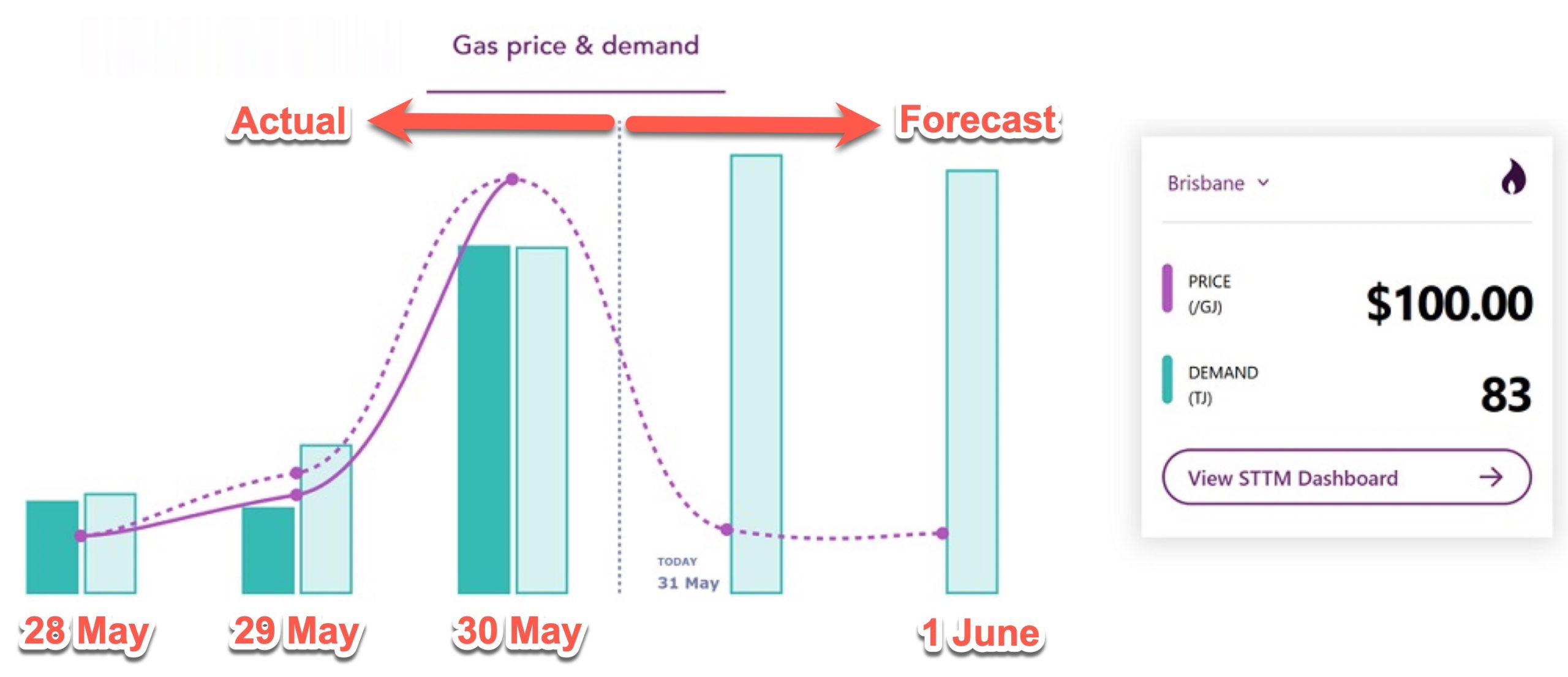
This graph from the Australia Electricity Market Operator (AEMO) shows gas hitting a cap of $100 per gigajoule in Brisbane. After this, the cap – the maximum price allowed – on natural gas prices was lowered to $40 a gigajoule.
While no one has to — technically — be doing anything wrong for gas prices to reach such high levels in our current system, a price spike like this is definitely cause for concern.
WA & NT Are Spared
Western Australia and the Northern Territory have their own electricity problems, but thanks to their own independent grids, they’ve dodged this particular bullet and haven’t had a ridiculous run-up in wholesale electricity prices.
What Are Wholesale Electricity Prices?
Wholesale electricity prices are what generators receive for supplying electricity to the grid. In this article, I’m using the term to refer to average wholesale spot prices for electricity sold on the wholesale market and not traded through long-term contracts.
Multiple Reasons
There are many reasons wholesale electricity prices have risen so high. High international natural gas prices triggered the situation, but that’s not enough by itself, as only a small portion of Australian electricity is generated from gas. The main factors involved are:
- The rise in international gas prices caused by the Russian invasion of Ukraine.
- The outsized role of gas generation in determining wholesale electricity prices.
- A lack of competition in electricity generation.
- Breakdowns and accidents at multiple fossil fuel power stations.
- Suspiciously convenient closure of power stations for maintenance.
- A stronger economy increasing electricity demand.
- Potential gaming of electricity market rules.
- Below average renewable energy output due to June being the worst month for Australian solar electricity production.
What I’d like to do is spend time going into this issue in detail and work out exactly what’s going on behind the scenes. But I’m on holiday, so I won’t. I’d like to do it, but I don’t like it so much that I’ll do it if I’m not getting paid. So instead, I’m going to tell you about the problem and then give a few suggestions on how ordinary Australians can cut gas consumption and hopefully get us out of this ridiculously high wholesale price situation sooner.
Reduce Gas Use For Ukraine!
I’ve already written about why Australia should reduce gas use in response to the invasion of Ukraine here:
The reasons I gave in that article are all still valid. If Australia had concentrated on reducing gas consumption four months ago, we might not be in our current situation. Unfortunately, our Federal Government at the time was too distracted to prepare for an obvious disaster in the making.
This time I’m asking people to Reduce Gas Use For Australia!
Some grumpy people may question why they should do anything to help solve a problem they didn’t create. While I can sympathize with people who suffer from inertia, that doesn’t mean I don’t think that attitude is stupid. Not being arsed to do anything is a position I can respect, but only if it’s combined with not complaining. If you want to whinge, you’ve got to do a thing.
Otherwise, you’re just a useless whinger instead of a useful one, and who wants to be that? If one person reduces their gas use, it won’t achieve much, but if a lot of people do it, it can and will help. We want to try to keep gas prices down, not only because homes are headed for higher gas bills in the future but because unless the current run of high wholesale electricity prices is soon stopped, we’ll see considerable hikes in our electricity bills.
Sky High Wholesale Electricity Prices
Below I’ve compared the average wholesale price in June 2019 with what it has been so far in June 2022:
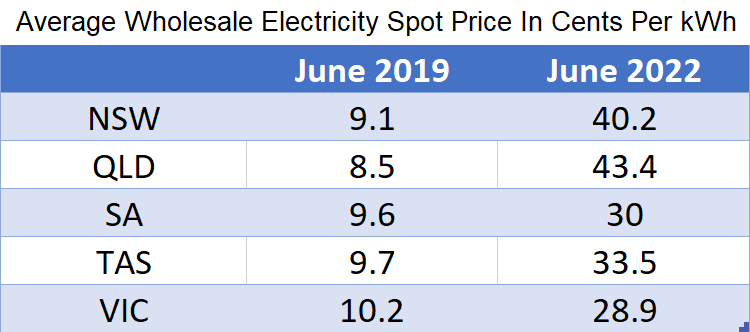
Note the information for June 2022 only goes up to the 23rd, and the electricity market was suspended for some of that time.
June 2019 was before the pandemic and before Queensland’s Callide black coal power station had a turbine explosion. Wholesale electricity prices have been over four times higher in NSW and QLD. Victoria has got off the lightest with under a three times increase.
Without long-term contracts, just 30 days of high wholesale prices like we’ve had so far this month would be enough to raise the cost of electricity by 2-3 cents per kilowatt-hour for a whole year. Hopefully, electricity sold through contracts will cushion that increase, but because contract information is kept secret, we’ll have to wait and see what happens. In the improbable event of high wholesale prices continuing over an entire year, this could more than double the residential cost of electricity per kilowatt-hour for most Australians.
Let me repeat that:
If high wholesale prices continue over a full year, this could more than double the residential cost of electricity per kilowatt-hour for most Australians.
Gas Is A Small Portion Of Generation
Australia generates little electricity from gas and the amount has been declining due to competition from solar energy and wind power and increasing battery storage.
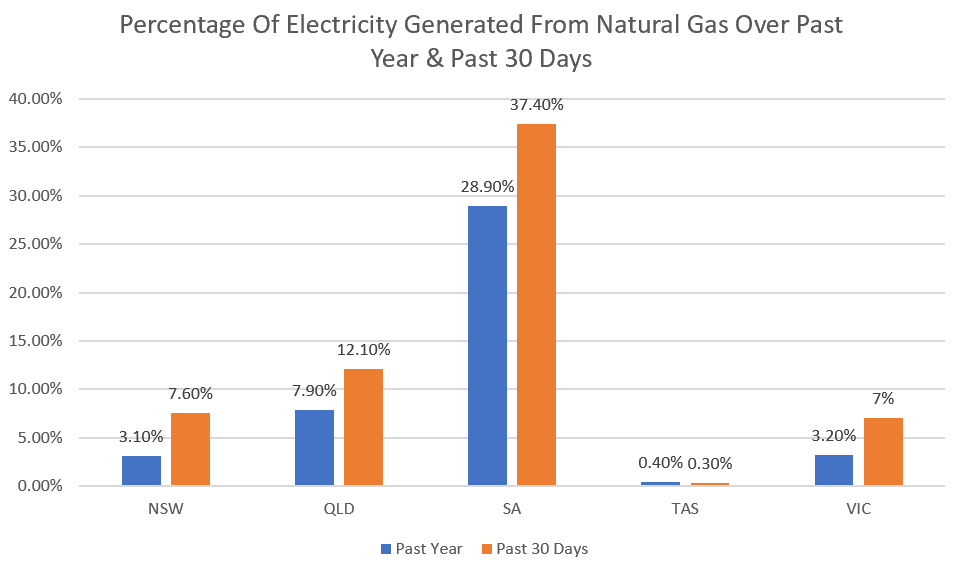
This graph doesn’t include the 0.9% of electricity QLD generated from coal mine waste gas, as I don’t think that can easily participate in electricity market shenanigans.
Gas generation in the past 30 days has been higher than the average for the past year because:
- Electricity consumption rises in winter.
- Solar electricity output is low in June.
- Fossil fuel capacity has been unavailable due to breakdowns and maintenance.
The eastern states have only generated around 9% of their electricity from gas over the past 30 days. With gas under one-tenth of total generation, you might expect any increase in gas prices to only have a small effect on wholesale electricity prices, but that’s not the way it works.
Because natural gas — along with usually much more expensive diesel and kerosene — fuels the most flexible forms of generation after hydropower1, it is often used to meet any shortfalls in generation and so “sets” wholesale prices. This is because, when we need gas generation, the high prices the gas generators bid in is received by all generation.
While much electricity generation is traded through contracts rather than the wholesale market, if high wholesale prices continue long enough, the increases will be incorporated into new contracts when renegotiated.
Burning Oil Instead Of Gas
Over the past two decades, the eastern states have generated an average of 0.03% of their electricity from diesel and kerosene. The amount is so low because, in normal times, they’re the most expensive fuels. But since the crisis started, diesel and kerosene generation has jumped by a factor of seven. The largest increase has been in South Australia, where it went from supplying 0.05% in June last year to 1.9% over the past 30 days. Almost 40 times more.
Anytime Australia generates a significant about of electricity from diesel and kerosene and it’s not the middle of a heatwave or there hasn’t been an unexpected failure at a power station, it indicates something very strange is happening.
Coal Price Increase Has A Modest Effect
The invasion of Ukraine has caused coal prices to soar to their highest point in history. Currently, Australian export coal is just under $400 per tonne. But, technically, this should only have a modest effect on wholesale electricity prices. This is because 26% of Australia’s coal generation comes from brown coal, which isn’t exposed to international market prices because it can’t be exported2.
Over the past year, black coal supplied 44.5% of eastern state electricity, but a large portion came from mines without access to international markets. Also, domestic coal prices are mostly set by long-term contracts, which should moderate the effect of recent increases. But for all I know, there could be generators loading coal they’ve contracted for onto ships for export. But even if all black coal generators had to pay the international price, this would only add around 13 cents per kilowatt-hour to their cost of generation. Well below the 20 to 30 cent increase in wholesale prices we’ve seen.
European Gas Prices
International gas prices are high due to a combination of some European nations deciding not to buy Russian blood-gas (ew!) or Russia being unable or unwilling to maintain supply. (I’m thinking unable, but I’m not there to check — thank god.) On Friday, the 24th of June, the price of gas in Europe was 127 Euros per megawatt-hour of thermal energy:
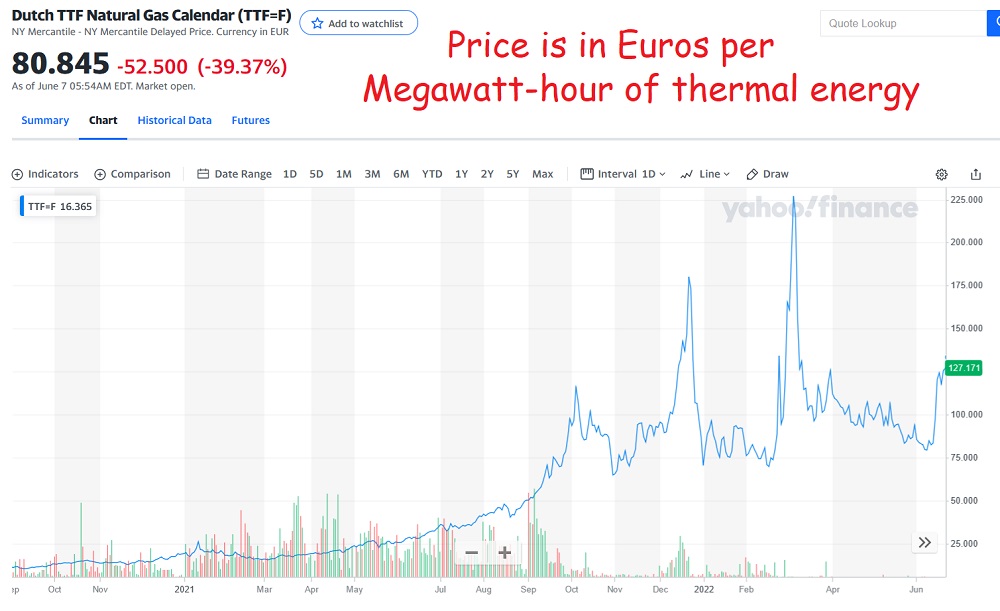
This graph of European natural prices is based on Netherlands data, which is a major gas hub. (Image: Yahoo! Finance – but not the red Comic Sans at the top. I did that.)
In Australia, natural gas is sold by the gigajoule. As there are 3.6 gigajoules in a Megawatt-hour, and 0.66 Euros to the Australian dollar, this means Europeans are currently paying $53 Australian per gigajoule. In Asia, where Australia exports natural gas, the price is almost as high — with fewer price spikes due to getting less gas from Russia.
Australians are currently paying close to European prices. At the start of the month, the price of gas was capped at $40 per gigajoule, but at the moment, gas is currently $43 in Sydney:
If gas at $40 per gigajoule is burned in generators with an average efficiency of 35%, then the fuel cost of one kilowatt-hour of electricity will be 41 cents. This is around the average wholesale price in QLD and NSW this month, despite gas supplying only 12.1% and 7.6% of electricity in those states over the past 30 days.
Wind & Solar Power Have Protected South Australia
Over the past 30 days, QLD has been paying the highest wholesale prices, while VIC has been paying the least ridiculous prices. During this time, South Australia’s portion of electricity generated from gas has been over three times higher than Queensland’s, but the average SA wholesale price has only been slightly higher than in Victoria.
The main reason for the difference is due to SA’s high level of renewable generation with 52.5% of the state’s electricity coming from wind and solar power over the past 30 days. This has resulted in long periods of low or negative electricity prices in the daytime and also sometimes late at night, as shown below:
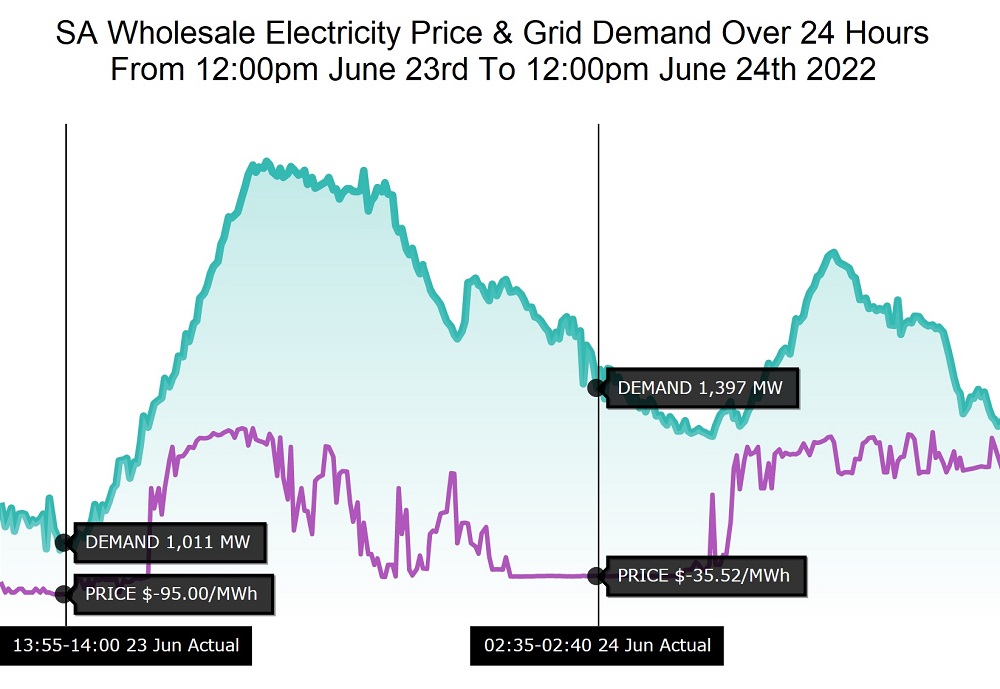
This graph was taken from the AEMO. So blame them if you don’t like it.
Death Of A Sales Mechanism?
The electricity market was suspended on the 14th of June and it has been suggested we make it permanent by reversing privatization and returning the grid to public ownership. On one hand, this would be a pity because I’m curious what our current system would look like if it was intelligently reformed to best serve the interests of Australians. But on the other hand, they have had over 20 years to get started on that and it hasn’t happened, so I’m thinking I’ll never see it.
This makes reversing privatization appear to be the better option. It’s not that I expect it will lead to a good outcome. I just think it’s likely to be less worse than the outcome we’ve had over the past quarter of a century or so. But I admit, I’d probably feel more confident about it if we didn’t have the example of Western Australia to show how easy it is to make a mess of an electricity sector. (Sorry WA, but it’s funny because it’s true.)
Gas Use Declining
Any major changes to the way electricity is supplied, such as de-privatization, will take time. Potentially, a very long time. But one thing we’re currently doing that helps is reducing gas generation. Last year in 2021, we generated only 53% as much electricity from gas as we did seven years earlier in 2014. This decline has been due to:
- The falling cost of solar and wind power generation.
- The falling cost of battery storage.
- Gas prices more than doubling in the eastern states due to exposure to international prices caused by Liquefied Natural Gas (LNG) export facilities coming online north of Gladstone.
Rooftop solar power has been responsible for a large portion of the reduction in gas use. If you get solar panels for your home, you’ll not only be helping yourself out financially by reducing your electricity bills, but you’ll also be helping everyone by reducing the ability of gas and other fossil fuel generators to drive up electricity prices.
The more rooftop solar power that is installed, the sooner your state will become like South Australia where renewable generation often keeps wholesale electricity prices at or below zero for long periods during the day. If anyone tries to convince you periods of zero or negative wholesale electricity prices are bad, there’s a good chance they’re in the pay of someone who owns a coal power station.
Cashed Up And Want To Help? Install A Battery.
Rooftop solar is cost-effective but only provides power during the day, while home batteries directly substitute for gas generation. This makes installing a home battery one of the most effective things a household can do to protect Australians from being held to ransom by high fossil fuel generator prices. This will be especially true if the battery is part of a Virtual Power Plant (VPP), which will enable it to send electricity into the grid when wholesale prices are high.
Unfortunately, the financial return from a battery is nowhere near as good as from a rooftop solar power system. But if you do install a home battery, you can pat yourself on the back for helping out the rest of us.
Faster Fixes
While Australians have received quotes and had solar panels installed within a week, with rising electricity prices demand for rooftop solar is also rising, so you can expect it to take considerably longer than that to get a solar system and/or a battery installed at the moment.
I’m hoping the current high wholesale electricity prices will ease over the next few weeks, but this may not happen. To help nudge things back towards normal, there are two areas in which everyday Australians can act:
- Reduce electricity use.
- Reduce gas use.
Cutting Electricity Consumption
The less grid electricity households and businesses use, the harder it will be for generators to get away with bidding in extremely high prices. So economising on its use will help ease wholesale electricity prices. It also makes sense considering electricity prices will be rising for most Australians in July.
Electricity conservation will reduce gas burned to generate electricity, but Australians with gas connections or bottled LPG gas have the option of directly reducing gas use.
Cutting Back On Gas
If you are a member of one of the many Australian households that:
- a) Have a gas connection, and
- b) Like money
…then my advice is to get rid of your gas connection before it gets rid of your money.
I’m expecting hefty increases in household gas charges in eastern states in July — except for Victoria, which will be hit with theirs in January. Getting rid of your gas connection saves you from paying the daily supply charge and the cost of having your gas appliances regularly inspected and maintained3.
Going all-electric can save a lot of money — especially if you have solar panels — however, doing so immediately won’t be practical for many people. But even if you keep your gas connection, you can still cut back on consumption. Some simple suggestions for doing this are:
- Use a reverse cycle air conditioner for heat instead of gas: Unless you have one of Australia’s least efficient air conditioners, this is considerably cheaper than gas if you use grid electricity and much cheaper when powered by rooftop solar. Substituting electricity for gas has the drawback of increasing electricity consumption, but the benefit from directly reducing gas use should be much greater.
- Cook with electricity: Use your microwave, plug-in electric hot plate, or induction cooker4. Now you’re not cooking with gas.
- Improve your home’s thermal envelope: Fix your home’s thermal envelope by fixing
- Gaps – seal any gaps in your home – this makes a huge difference for a typical draughty Australian home, for little cash and little effort.
- Glazing – most Australian windows use the cheapest 3mm glass and thermally conductive aluminium frames. Invest in good windows or secondary glazing.
- Insulation. Please, just get your roof, walls and floors insulated where possible.
Arranging glazing and insulation take time, but there are plenty of gaps you can seal right now.
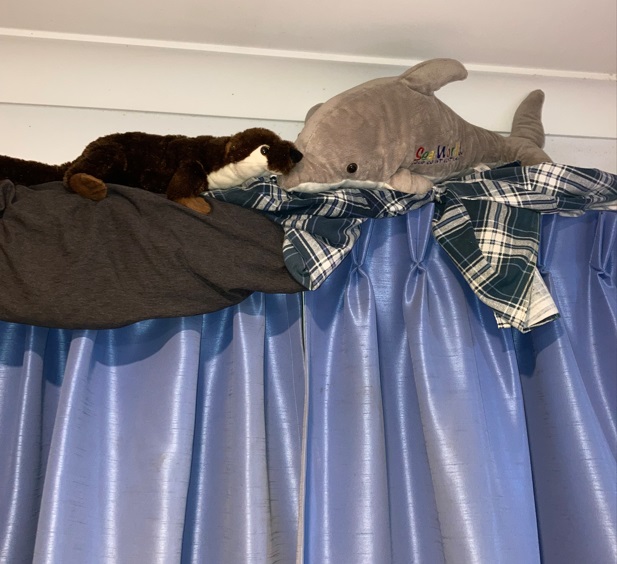
Screw you cold! You’ll have to get through my plush dolphin and stuffed ferret first!
And secondary glazing can be done cheaply with glass, pneumatic piping and cable clips:
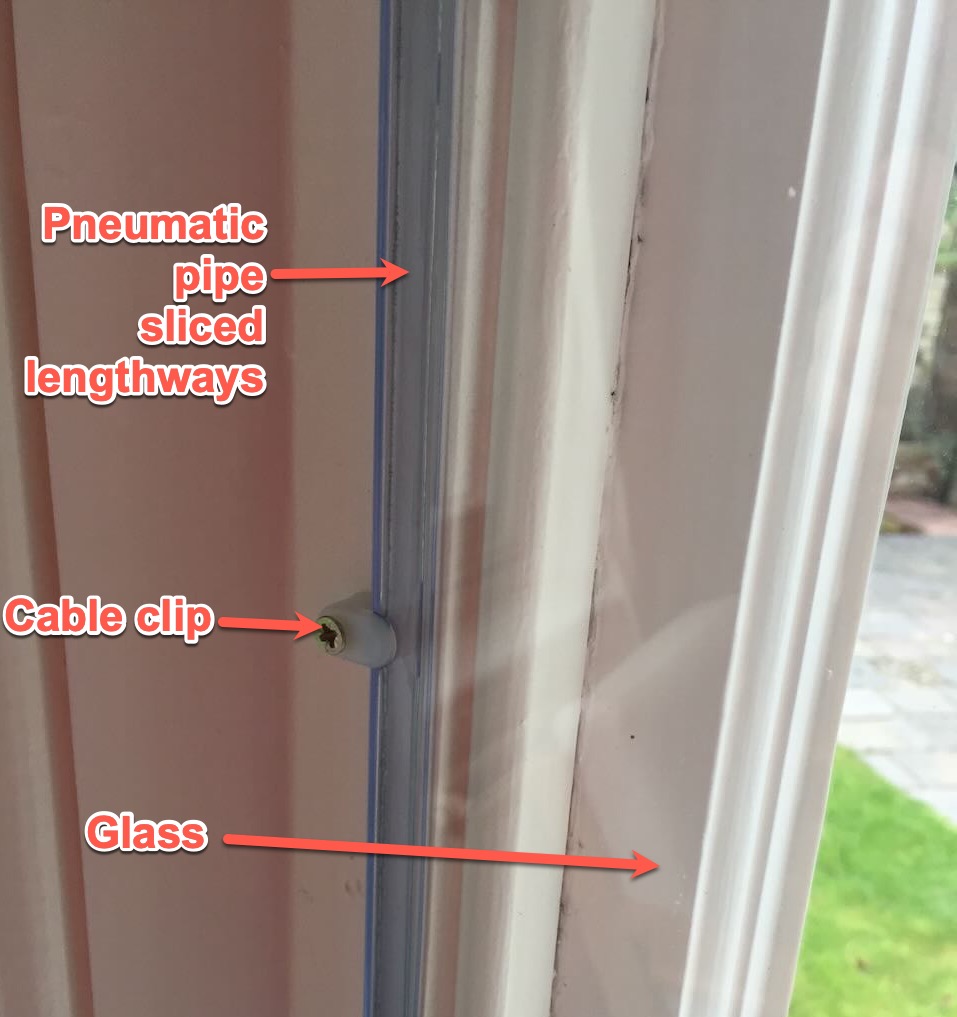
Efficiency isn’t always expensive: A friend’s secondary glazing. Effective, good-looking and cheap.
Prepare For Higher Electricity Prices
International gas prices are especially high right now because Europe is attempting to fill its gas reserves in preparation for winter. Prices could drop once European reserves increase, but it’s also possible that there will be further reductions in Russian gas exports, pushing prices higher. Europe is installing more solar and wind power capacity and replacing gas heating with electric heat pumps — but they’re not doing this as fast as they should.
Coal will soon fall from its current record-high price, as it can’t be sustained. Several poorer countries will stop importing it if they have to pay that price. While high coal prices only have a modest effect on Australia’s average cost of generation, a price reduction will still help.
How long international energy prices will remain high depends on who you talk to. Some say the Russian military could crack and withdraw from Ukraine within a month, while others say fighting could go on for years. Personally, I expect fighting to be over sooner rather than later, given how incompetent Putin’s kleptocratic, authoritarian regime has been at anything more complex than simple extortion. But time will tell.
While I expect prices to ease, unless there is further intervention in the market, high wholesale prices could continue through July and potentially the rest of winter, only easing as the weather warms and solar energy output increases in spring. At the moment, I’m expecting high residential electricity prices next financial year and — unless we have a major economic slowdown — high prices will continue into the financial year after that.
Solar Feed-in Tariffs Will Increase
Wholesale electricity prices are the primary determinant of solar feed-in tariffs, so they will increase. A one-cent rise in average wholesale prices won’t result in a one-cent rise in feed-in tariffs because wholesale price increases during the evening have been higher than during the day. But I expect to still see significant increases.
High electricity prices combined with higher solar feed-in tariffs mean this is an excellent time to either install solar panels or expand existing capacity.
Australia’s Final Wholesale Electricity Price Gouge?
While an increase in wholesale electricity prices in Australia was inevitable given international natural gas and coal prices, the actual cost of generating electricity here has not increased anywhere close to the 20-30 cent increase in wholesale prices per kilowatt-hour. Prices have only gone that high because generators have been able to get away with charging that much.
I’ve been a little surprised at how eager generators have been to raise prices. They either weren’t concerned about the possibility of the market being suspended or were intentionally aiming for it. But high wholesale prices may simply be due to them — quite sensibly from their point of view — charging as much as they could and so are the natural result of them maximizing their return.
But it has occurred to me that there may be an even more devious reason behind their lack of restraint. As the amount of solar, wind, and battery storage grows, generators may worry that they won’t have the market power to drive up wholesale prices for much longer. They may be taking advantage before their opportunity is gone for good.
On the other hand, my mother always told me not to attribute to cunning what can just as easily be explained by basic self-interest. Generators could simply be charging as much as they can get away with and will continue to do so for as long as they can.
Footnotes
- Batteries are more flexible than gas and hydropower, as they can start and stop supplying power almost immediately but are not a source of generation and have to be charged with something — preferably low-cost renewable energy. Current total battery power output is small compared to the total potential power output of gas generation. ↩
- Brown coal literally can’t be safely exported because of its tendency to self ignite if it dries out. ↩
- You are all paying to have your gas appliances regularly inspected, as required by laws of your state or territory, right? In NSW, it has to be done every two years. That adds up to a lot of money over a decade. ↩
- Induction cookers are more efficient than conventional hot plates, but the difference isn’t large so don’t stress over it. ↩


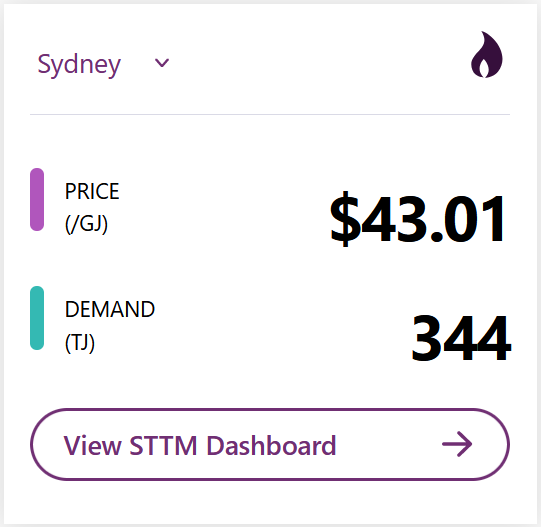
 RSS - Posts
RSS - Posts



I like the glass idea, when double glazing is in the order of $1000+ per sqm your mods with some poly tube makes sense.
Now that AEMO has since handed back control, prices jumped again, AEMO had them pegged to about 40 to 45 cents, even went down to 10c when the sun was out! now AEMO is out of the picture is now 50 to 60 cents wholesale all day, with spikes due today and tomorrow up to $12 and $17 a kwh.
Sucks to be on wholesale power at the moment, but getting more solar and battery installed soon, financial incentives are not even coming into the equation, power surety is the main driver over the next few years. Went from $100 a month to $400 a month with this current instability though so financial payback may start making sense.
Induction cooking seems to make sense if power is cheap as the new ones max out around 11,000W which is a fair whack, albeit peak power so may not be so bad longer term compared with the gas.
“Induction cooking seems to make sense if power is cheap as the new ones max out around 11,000W which is a fair whack…”
My new Miele induction top is on a 32amp circuit which means it can’t possibly pull 11kW. 240v x 32A = 7680W (7.68kW). I’m usually running the top off my Powerwall which has a maximum output of 5kW continuous (7kW peak).
yeah, was the new 90cm wifi Bosch one that pulls 11kw(am a sucker for smart home gear), the rest as you say are around 7-8kw, which I think is in short bursts to boil water in the worst case, so even at that level likely never an issue even with a power wall as you’ll turn it down to cook.
If you just want to buy the glass and not the whole frames you can expect to pay under $250 per square metre. If you can fit another sheet of glass like Ronald’s mate has, I imagine the frame will accept a sealed double glazed pane https://www.canstar.com.au/home-loans/double-glazed-windows-cost/
My view – I appreciate that international gas prices have risen somewhat due to the war, but WHY have domestic prices risen so much in the Eastern states??
I suspect because our past government/s let the gas companies have their way with us and our resources, and never forced Santos and others to reserve a % of production for domestic use as per WA? What a disgrace that we have to effectively buy back our gas to keep our lights on!
Many said a reserve would not work in WA and that the world would end, but it has worked very well for WA in the current circumstance.
Or is it that our domestic gas prices are pegged to the international price by legislation, as is the case for oil? I don’t know the situation here.
Whatever, Australia produces copies amounts of gas relative to oil, so there is NO excuse for high domestic gas prices and its effects of crippling families and business!
The fact that our gas electricity production has dropped is an indictment of the past government, because it means we have not moved away from the much more polluting coal, which in turn means we would have polluted much less while we worked toward battery storage solutions.
We could of course produce a heck of a lot more gas, if NSW and VIC allowed gas production in their states, rather than doing the politically advantageous thing, and pleasing a few by banning production there, but all the while taking gas and electricity from Queensland where sense has prevailed with regard to gas production wells.
The move away from coal and then from gas needs to be done with a realistic TRANSITION PLAN (hello the past Government!), if we don’t want to wreck the country, and the plan is needed urgently.
Roy,
“I suspect because our past government/s let the gas companies have their way with us and our resources, and never forced Santos and others to reserve a % of production for domestic use as per WA?”
Yep. You may find an on-air discussion broadcast between Radio 2GB host Michael McLaren and outgoing Senator Rex Patrick on Jun 9 of interest. In the podcast, from time interval 0:07:47, Senator Patrick said:
““What we can say from that, is that every couple of years we end up with a crisis. We end up with governments playing brinkmanship with the gas cartel and getting some form of outcome, when in actual fact, what we really need to do, is move to a gas reservation policy. And in 2019, I negotiated with the government as part of discussions on tax cuts, and got a written agreement from them, that they would move to introduce a gas reservation policy. Sadly, they didn’t, and we find ourselves in the situation we are now, where people again as I said before, are playing at the fringes, when, what has to happen is governments need to put national interest, the interests of our manufacturers, the interests of our consumers, ahead of the commercial interests of some of these gas cartel companies.”
https://www.2gb.com/podcast/outgoing-senator-slams-the-gas-industry-as-a-cartel/
Rex Patrick tweeted Jun 8:
https://twitter.com/Senator_Patrick/status/1534269641635557376
Will the new Labor government acquire the courage to introduce a national gas reservation policy, or cower from the gas cartel, like the previous Coalition government seems to have done? We’ll see.
ANother fine example of the Australian government selling out our country from. under us…
June is the worst month for Australian solar generation? Not this year. May well and truly blew June out of the water!!!
June isn’t over yet so I don’t have the final figures, but May’s total generation averaged about three-quarters of this month’s average exports, perhaps something like 60% of June’s average daily generation – my inverter data got corrupted again with another blackout so I can’t just look up the monthly figure, and my retailer only monitors exports not total generation or self-consumption.
A couple of days to go, but my June solar output likely to be close to double May’s
June has always been the lowest solar production month for the last 11 years I’ve had solar PV But it’s July when consumption goes higher as July is traditionally colder than June, even though the Winter Solstice has passed, there’s a thermal delay from the cold onset kicking in later, but July sees about a 15% increase in solar PV production from June.
On the other hand, December is always my highest solar production month as expected (Summer Solstice).
But overall, last 12 months, my solar PV production has decreased by about 1000kWh on account of back to back La Nina events with more cloudy weather. Looking back on my solar production figures over 11 years, I’ve mapped out the BoM ENSO events and I’ve noticed that El Nino active events lines up with my highest solar PV production figures and active La Nina events ties in with the lowest. Neutral events (neither Nina or Nino) have solar production somewhere between the two extremes. Bring back El Nino… more sunny days = more solar PV production……
With all the trenchant abuse and criticisms of coal and gas over a very long time, it’s difficult to understand why we still bother to use it after all these years. Could it be that we need it because it gets chilly in the night when the sun doesn’t shine and batteries don’t provide enough power economically?
On the other hand, now that the Albanese/ Bowen cavalry has arrived,
things will soon be fine in no time at all——–and of course much cheaper for us too. Then all those profiteering coal and gas companies will be out of business———-yeah?
You should probably ask your mother to explain how politics actually works.
Heya Ronald.
What a clever article: Well written, informative and entertaining. Thanks for putting in the time, even though you were on hols.
Cheers!
Tim.
If you’re producing excess solar during the day, an alternate or addition to adding a battery is to install a Catchpower relay – a smart device that diverts excess solar to your hot water system.
Sadly my hot water tank seems to have a preference for charging when there’s not enough solar – sometimes as much as 4x in a single day. Needless to say that puts my imports up!!! :-/
Go and regularly and look at https://anero.id/energy. You will find GW of potential wind power in Victoria running less than 30%.
People are told here’s another 400MW wind farm up and generating power when in reality they average 30% or less and then all the coal plants have to run above 100%.
Loy Yang B power station is always running 115% – this is why fossil fuel power stations have to go down for maintenance – you cant run systems over 100% for long without failures.
Sure renewables are good when they work but base load of 30,000GW is needed for near 4hrs at night to keep this country running and has to be affordable. I believe there’s a new battery going in NSW that’s 4 times bigger than SA, but that’s only a 1/30 of the load needed and its needed for hours not minutes. This doesn’t take into account temp extremes or when the wind isn’t blowing or sun not shining. Off griders know they need days of reserves to avoid being in blackout!
Nuclear is probably the only viable solution for the next few decades or so than batteries. Also those wind turbines blades aren’t yet recyclable – possibly one can burn them instead of landfill but…..
The power situation is only going to get worse as the financial system is anti-coal and companies and public want those plants shutdown but without meaningful replacements (Loy Yang B is 580MW base load!) people are going to be in the dark or pay much higher rates for power.
Look at Germany the darling of the renewable world is bringing back coal power as it’s renewables aren’t meeting demand and they cant rely on Russian Gas, they also stretching their nuclear plant life expectancy meanwhile France is adding more nuclear and is net energy exporter for Europe.
RobertW,
“Nuclear is probably the only viable solution for the next few decades or so than batteries.”
Evidence/data indicates that’s a fantasy. Nuclear is the most expensive form of energy, and any Australian power reactor wouldn’t start producing electricity until at least some time in the 2040s.
https://theconversation.com/if-the-opposition-wants-a-mature-discussion-about-nuclear-energy-start-with-a-carbon-price-without-that-nuclear-is-wildly-uncompetitive-184471
Meanwhile, coal-fired power stations in NSW in the order of closure dates:
* Liddell unit 3 (420 MW) closed on 2022 Apr 01;
* Liddell remaining units (3x 420 MW) announced closure for 2023 Apr 01;
* Eraring (4x 720 MW) announced closure for 2025 Aug 19
* Vales Point B (2x 660 MW) expected closure by 2029;
* Bayswater (4x 660 MW) expected closure by 2033;
* Mt Piper (2x 730 MW) expected closure by 2040, but local coal supplies are precarious beyond 2026 (Springvale mine reserves exhausted by 2024, Angus Place mine expires in Aug 2024, Clarence mine expires end-2026, Invincible & Cullen Valley mines expire end-2025, Airly mine expires in Jan 2037 with inadequate 1.8 Mt/y ROM maximum allowable production rate).
For Victoria:
* Yallourn W (4x 360 MW) announced closure by 2028;
* Loy Yang A (1x 530 MW, 3x 560 MW) expected closure by 2045, but Units 1 & 2 are already 38 years old, & Units 3 & 4 are 35 years old;
* Loy Yang B (2x 535 MW) expected closure by 2047, but these are already middle-aged (29 & 26 years old).
For Queensland:
* Callide B (2x 350 MW) expected closure by 2028;
* Gladstone (6x 280 MW) expected closure by 2035, but it’s already 46 years old and increasingly unreliable;
* Tarong (4x 350 MW) expected closure in 3036-37, but it’s 38 years old;
* Stanwell (4x 365 MW) expected closure 2043-46, but it’s 29 years old;
* Callide C (2x 460 MW) expected closure not yet announced;
* Millmerran (2x 440 MW) expected closure in 2051;
* Kogan Creek (1x 750 MW) expected closure in 2042.
The evidence indicates the NEM will be without adequate generating capacity for a very long time (and increasingly less reliable with aging coal plants) if Australia waits around for any horrendously expensive nuclear generators to become operational.
That’s pretty terrifying list of loss of power over the coming decades!
However looking at https://anero.id/energy the wind farms are probably located where the wind is the most reliable (in theory) and economically to the grid and yet in Victoria these past months they’re not producing anything reliable to that of coal/gas.
Sadly the spin from media/investment companies is about the total capacity that a farm can produce and how many houses it could power and not its average capacity. Look at Macarthur Wind Farm in Wikipedia “Macarthur has consistently been one of the worst performing wind farms since its construction in 2012.” and its probably mid-life as well!
The problem is that the lack of investment in coal plants to build new ones unlike in China which apparently popup new ones weekly means the country is going to have higher bills and more black outs.
Nuclear power though expensive would solve the immediate problem if we stopped F#ing about and started work on it but we’re more interested in just complaining about power and worrying about when our Submarines are built and what colour they are. So also Snowy #2 and while at it more dams and pumped hydro!
I was interested in geo-thermal power but my investment in that turned out to be a dud as the company realised it was too hard or not profitable and switched to mining instead! ZBB a company doing flow batteries also died out too so am hoping Redflow batteries can keep growing and moving forward…
RobertW,
“That’s pretty terrifying list of loss of power over the coming decades!”
Yep. It’s not something that the power industry, and Australia’s business and political leaders don’t know about.
For example: https://www.aph.gov.au/Parliamentary_Business/Committees/Senate/Environment_and_Communications/Coal_fired_power_stations
IMO, Australia’s current energy crisis is as a consequence of at least two decades of incompetent political & business energy policy leadership and wilful ignorance.
“Look at Macarthur Wind Farm in Wikipedia “Macarthur has consistently been one of the worst performing wind farms since its construction in 2012.””
And then there are Australia’s top wind asset performers for balance.
https://reneweconomy.com.au/chart-of-the-day-australias-best-performing-wind-farms-in-may/
“The problem is that the lack of investment in coal plants to build new ones…”
Nope. Coal plants are more expensive and slower to deploy compared with renewables + storage. Investors know this.
And then there’s the pesky problem of GHG emissions that are progressively leading to an Earth System increasingly more hazardous for humanity and human civilisation. The Australian Security Leaders Climate Group published an assessment of the consequences in their report yesterday (Jun 28) titled Food Fight: Climate change, food crises & regional insecurity.
https://www.aslcg.org/reports/
Similarly: http://www.climatecodered.org/2022/06/defence-agencies-accelerating-risk-of.html
“Nuclear power though expensive would solve the immediate problem if we stopped F#ing about and started work on it…”
Proposed deployments of any nuclear power plants in Australia that would not be operational until the 2040s at the earliest is undeniably not solving the “immediate problem”. I’d suggest you need to please stop fantasizing about false promises and look at the inconvenient evidence/data.
Robert, thanks for the very informative link!!!
Had a quick skim around the site, but will look in more detail another time. Even in SA – which has spent heavily on wind and solar, the current figures don’t look good – relying on gas for a lot!
Geoff’s link shows even the best wind farms can’t average 45% of capacity, but some states are far worse – Queensland’s best is barely 35%, and your anero.id site has it currently producing at 3%. It’s really quite funny, but wouldn’t be if you were actually relying on it for power!
George Kaplan,
“Queensland’s best is barely 35%, and your anero.id site has it currently producing at 3%.”
Looking at the Current Fossil Energy Generation webpage, the map includes outputs on 1 Jul 2022 at 10:55 AEST:
for NSW showing:
* Broken Hill Gas Turbines: 0% (0 of 50 MW);
* Uranquinty Power Station: 0% (0 of 166 MW);
* Tallawarra Power Station: 93% (409 of 440MW);
* Mt Piper Power Station: 104% (728 of 700MW);
* Smithfield Energy Facility: 0% (0 of 185MW);
* Colongra Power Station: 97% (176 of 181MW);
* Vales Point “B” Power Station: 91% (602 of 660MW);
* Eraring Power Station: 82% (593 of 720MW);
* Bayswater Power Station: 103% (681 of 660MW);
* Liddell Power Station: 70% (350 of 500MW);
https://anero.id/energy/fossil-energy
The webpage indicates that totals only 3,539 MW of fossil fuel production (for NSW at the indicated time). Is that all? Where’s the rest?
Liddell still includes about 3x 420 MW (derated from 500 MW each) capacity available;
Eraring includes 4x 720 MW capacity;
Vales Point B includes 2x 660 MW capacity;
Bayswater includes 4x 660 MW capacity;
Mt Piper includes 2x 730 MW capacity;
totaling about 9,560 MW.
IMO, it seems something is not right about the data being displayed. George, in other words, be careful accepting things at face value.
“It’s really quite funny, but wouldn’t be if you were actually relying on it for power!”
Coal may exit Australia’s grid a lot quicker than most people think.
https://reneweconomy.com.au/coal-may-exit-australias-grid-a-lot-quicker-than-most-people-think/
Wouldn’t that be a hoot, George? ?
That is a nasty looking list, The grid is already looking unstable and we are losing 1260MW in under a year.
I have not seen the new government announce anything yet that adds capacity to our system, they are currently just juggling with the mess they have been handed, and saying they want to build more wires.
Snowy 2.0 looks like its going to cost as much, and take as long to build as Nuclear so that is taking the shine of the pumped Hydro idea.
The hope i had after the election is fading away.
James,
“The grid is already looking unstable and we are losing 1260MW in under a year.”
New generation, storage and transmission are being added and also in the planning pipeline (and most will likely be added).
https://reneweconomy.com.au/new-generation-and-storage-pipeline-reaches-150gw-as-aemo-prepares-its-plan/
“Snowy 2.0 looks like its going to cost as much, and take as long to build as Nuclear so that is taking the shine of the pumped Hydro idea.”
Evidence/data says otherwise.
Snowy 2.0 adds up to 2,000 MW of generation capacity with 40-350 GWh storage.
https://www.solarquotes.com.au/blog/snowy-2-vs-battery-storage/#comment-1019289
Snowy 2.0 was announced in 2017, and may not begin delivering power until 2028, with a blowout of costs from an initial AU$2 billion to potentially $10 billion (by some estimates).
https://reneweconomy.com.au/bowen-slams-morrison-and-taylor-for-hiding-extent-of-snowy-2-0-delays/
UK’s Hinkley Point C nuclear power station project (2x 1,630 MWe capacity) was given the green light by the UK government in January 2008. The latest revised operating date for unit 1 is currently estimated for June 2027. Total costs for the project have blown out to the range of £25 to £26billion (AU$44.16 to 45.92 at current exchange rate).
https://www.bbc.com/news/uk-england-somerset-61519609
Also, I’d suggest Snowy 2.0 is not a good representative example for what can be done with pumped-hydro in Australia. IMO, it’s an example of how politicians can interfere with and stuff up already marginal projects big time (for it seems a good photo opportunity)! There are potentially many more cost-effective pumped-hydro sites available in Australia, and around the world.
http://re100.eng.anu.edu.au/global/
“Nuclear is probably the only viable solution for the next few decades or so….”
The downside of that being Australia doesn’t have the Academic, Professional, Trades nor Industry bases for that.
So everything has to be imported, and as is the case with our Lucas Heights nuclear waste, exported.
It only takes 1 psychopath to disrupt everything, see Putin vis a vis Ukraine and the the global systems then creak and fail.
We have another such human time bomb to our immediate north who is making noises and should Putin be successful, Xi will jump. That will stuff up shipping from Asia, both North, Japan and Korea and South East, Singapore. So everything will have to come around the Cape.
While we clever people in the west pontificate about the “correct” choice of power sources and of course rule out continuing with the power generation we have successfully done for decades, the Chinese and Indian governments build more and more coal fired power stations ( blissfully leaving us to worry about climate change) and thus produce the levels of power they need. That looks like the sort of ” stupidity and selfishness” we need to support our power requirements.
But, I’m sure I’m missing something and some clever person out there will tell me where I’m wrong and of course how we are going to overcome the terrible power shortages Geoff Miell details.
Australia could stop selling coal, thereby raising the prices to a point where they cost to much to run.
Look what has happened to the price of coal from the Ukraine conflict, i am sure that is still with Russia selling it to India and China.
Would getting rid of my LPG (bottled gas) fuelled stove top and barbecue help the fight against Putin?
Not filling it up again for a while would help a very small amount. As far as energy markets are concerned, per joule of energy, natural gas and LPG are nearly the same thing. Maybe try a wood fired BBQ for a while?
Ronald,
“ As far as energy markets are concerned, per joule of energy, natural gas and LPG are nearly the same thing.”
Evidence/data indicates otherwise. For example (bold text my emphasis):
https://www.elgas.com.au/blog/486-comparison-lpg-natural-gas-propane-butane-methane-lng-cng/
?♂️
https://climatenewsaustralia.com/lpg-vs-natural-gas-is-there-a-clear-winner-extendednew-int/
“Maybe try a wood fired BBQ for a while?”
Ronald, did you forget about these?
1) https://www.solarquotes.com.au/blog/solar-power-slow-cookers/
2) https://www.solarquotes.com.au/blog/reduce-gas-use-for-ukraine/
3) Field Test – Induction Vs. Gas Cooktops at time interval 0:9:05 in: https://www.solarquotes.com.au/blog/solarquotes-tv-ep1-mb1872/
It certainly would. Although that small pimple may take a while to filter through to Vlad.
The impact on you would be immediate, but you could bask in the warm glow of “doing your bit”. 😉
Enjoyed reading the blog and all the comments here. Writing this upon the receipt of a letter from QEnergy here in Victoria saying the Daily Supply Charge is set to double from 1st August 2022 from ~49c/day to ~107c/day, with supply charges on top. Tough times ahead if this keeps up.
Looking holistically, you can’t expect to solve global problems when the situation at home is a mess. Coming up with a model that provides a sound foundation provides an example for others to follow in the future.
Problems identified:
1. Privatised Energy sector (laughing all the way to the bank while citing near and far market effects) not bound ethically / morally to the population it provides for nor the materials it draws on (abuse of natural / raw materials for personal gain)
2. Inept Governance (as per the norm) and lack of transition planning / direction towards a stable model of energy supply that provides for all
3. Myopic cult-like focus on “green energy” and lack of appreciation of the nature of electricity generation / supply / grids / demand and the time required for transitioning to other modelities while maintaining adequate function. The planned shut-downs and demonisation of certain modes of electricity supply (which have served us well) is truly short-sighted not to mention highly irrational and is one borne out of decades of frustration at item no. 2 above.
4. Continued participation / belief in the 2-party system where one party can enact policies only for another to undo 4-8 years later. Meanwhile we onlookers continue to shake our heads. How do we expect these “Career Politicians” who often lack real world experience / skills to be able to make holistic decisions, let alone communicate effectively, especially across party lines ?
Possible solutions:
1. A clear plan for a balance of energy supply modalities contributing to larger grids (cities) understanding that each fulfills a role (ie, Nuclear, Coal, Gas, Hydro, Wind, Solar).
2. A focus on decentralised power supply (lower transmission costs) and adequate incentives for transitioning (ie, household solar panels and small localised residential grids ?). Creates buy-in from the local population and less of a reliance on the mafia state of affairs we find ourselves in
Food for thought.
Paul Masemann,
“Possible solutions:
1. A clear plan for a balance of energy supply modalities contributing to larger grids (cities) understanding that each fulfills a role (ie, Nuclear, Coal, Gas, Hydro, Wind, Solar).”
Nuclear for Australia is too slow to deploy (evidence indicates if committed to now then the first operating nuclear generator is likely in the 2040s at the earliest, while most of the NEM’s coal-fired generator units will have already been retired) and is far too expensive compared with other technologies.
See my comments at: https://www.solarquotes.com.au/blog/solar-supply-chain-mb2546/#comment-1480179
Also: https://www.worldnuclearreport.org/World-Nuclear-Industry-Status-Report-2021-773.html
GHG emissions from fossil fuels (coal, gas & petroleum oil) are facilitating a global warming trajectory towards an Earth System incompatible for human civilisation later this century.
See a presentation in Mar 2022 by a former Australian Chief Scientist (Nov 2008 to Mar 2011) and now ANU Professor Penny Sackett to the NSW Independent Planning Commission (IPCN) re the proposed Glendell Continued Operations Project at: https://m.facebook.com/Lock.The.Gate.Alliance/videos/professor-penny-sackett/1054072598796855/
Transcript (from page 15) at: https://www.ipcn.nsw.gov.au/resources/pac/media/files/pac/transcripts-and-material/2022/glendell/220321_glendell_public-hearing-day-2-transcript.pdf
Professor Penny Sackett’s presentation slides at: https://www.ipcn.nsw.gov.au/resources/pac/media/files/pac/projects/2022/02/glendell-continued-operations-project-ssd-9349/public-hearing-presentations/220318-penny-sackett.pdf
See also my compilation of data re the climate and energy crisis in a pdf file (10.4 MB) lodged with the IPCN on Jul 8 as an attachment to my Submission re the Mt Pleasant Optimisation Project at: https://www.ipcn.nsw.gov.au/resources/pac/media/files/pac/project-submissions/2022/05/mt-pleasant-optimisation-project-ssd-10418/20220708t144208/theclimateenergycrisis20220708.pdf
Food for your thoughts.
Jesus Christ on a bicycle (to apropriate a quote from Mountbatten as Supreme Commander SEAC (SE Asia) in 1944 when he saw a DC3 snatch a tethered cable and doing a flying medivac from a jungle clearing) our Daily Supply Charge here in the northern New England region is damned near $1.60 a day!
Hmmm. Given that disputes their access to their own generators, all three of big retailers have withdrawn all offers – you can see this plain as day at Origin.com.au, EnergyAustralia.com.au and agl.com.au – you would think that the demand is being puppeted… something doesn’t add up.